Why did we wait so long for the bicycle?
by Jason Crawford · July 13, 2019 · 11 min read
The bicycle, as we know it today, was not invented until the late 1800s. Yet it was a simple mechanical invention. It would seem to require no brilliant inventive insight, and certainly no scientific background.
Why, then, wasn’t it invented much earlier?
I asked this question on Twitter, and read some discussion on Quora. People proposed many hypotheses, including:
-
Technology factors. Metalworking improved a lot in the 1800s: we got improved iron refining and eventually cheap steel, better processes for shaping metal, and ability to make parts like hollow tubes. Wheel technology improved: wire-spoke (aka tension-spoked) wheels replaced heavier designs; vulcanized rubber (1839) was needed for tires; inflatable tires weren’t invented until 1887. Chains, gears, and ball bearings are all crucial parts that require advanced manufacturing techniques for precision and cost.
-
Design iteration. Early bicycles were inconvenient and dangerous. The first version didn’t even have pedals. Some versions didn’t have steering, and could only be turned by leaning. (!) The famous “penny-farthing” design, with its huge front wheel, made it impossible to balance with your feet, was prone to tipping forward on a hard stop, and generally left the rider high in the air, all of which increased risk of injury. It took decades of iteration to get to a successful bicycle model.
-
Quality of roads. Roads in the 1800s and earlier were terrible by modern standards. Roads were often dirt, rutted from the passage of many carts, turning muddy in the rain. Macadam paving, which gave smooth surfaces to roads, wasn’t invented until about 1820. City roads at the time were paved with cobblestones, which were good for horses but too bumpy for bicycles. (The unevenness was apparently a feature, assisting in the runoff of sewage—leading one Quora answer to claim that the construction of city sewers was what opened the door to bicycles.)
-
Competition from horses. Horses were a common and accepted mode of transportation at the time. They could deal with all kinds of roads. They could carry heavy loads. Who then needs a bicycle? In this connection, it has been claimed that the bicycle was invented in response to food shortages due to the “Year without a Summer”, an 1816 weather event caused by the volcanic explosion of Mt. Tambora the year earlier, which darkened skies and lowered temperatures in many parts of the world. The agricultural crisis caused horses as well as people to starve, which led to some horses being slaughtered for food, and made the remaining ones more expensive to feed. This could have motivated the search for alternatives.
-
General economic growth. Multiple commenters pointed out the need for a middle class to provide demand for such an invention. If all you have are a lot of poor peasants and a few aristocrats (who, by the way, have horses, carriages, and drivers), there isn’t much of a market for bicycles. This is more plausible when you realize that bicycles were more of a hobby for entertainment before they became a practical means of transportation.
-
Cultural factors. Maybe there was just a general lack of interest in useful mechanical inventions until a certain point in history? But when did this change, and why?
These are all good hypotheses. But some of them start to buckle under pressure:
The quality of roads is relevant, but not really the answer. Bicycles can be ridden on dirt roads or sidewalks (although the latter led to run-ins with pedestrians and made bicycles unpopular among the public at first). And historically, roads didn’t improve until after bicycles became common—indeed it seems that it was in part the cyclists who called for the improvement of roads.
I don’t think horses explain it either. A bicycle, from what I’ve read, was cheaper to buy than a horse, and it was certainly cheaper to maintain (if nothing else, you don’t have to feed a bicycle). And it turns out that inventors were interested in the problem of human-powered vehicles, dispensing with the need for horses, for a long time before the modern bicycle. Even Karl von Drais, who invented the first two-wheeled human-powered vehicle after the Year without a Summer, had been working on the problem for years before that.
Technology factors are more convincing to me. They may have been necessary for bicycles to become practical and cheap enough to take off. But they weren’t needed for early experimentation. Frames can be built of wood. Wheels can be rimmed with metal. Gears can be omitted. Chains can be replaced with belts; some early designs even used treadles instead of pedals, and at least one design drove the wheels with levers, as on a steam locomotive.
So what’s the real explanation?
To understand this, I dug into the history of the bicycle.
The concept of a human-powered vehicle goes back many centuries. The earliest reference I have found is to Venetian engineer Giovanni Fontana, who in the early 1400s described a four-wheeled carriage powered by a driver pulling on a loop of rope connected by gears to the wheels (it’s unclear if he ever even attempted to build such a machine; Fontana sketched a lot of strange things).
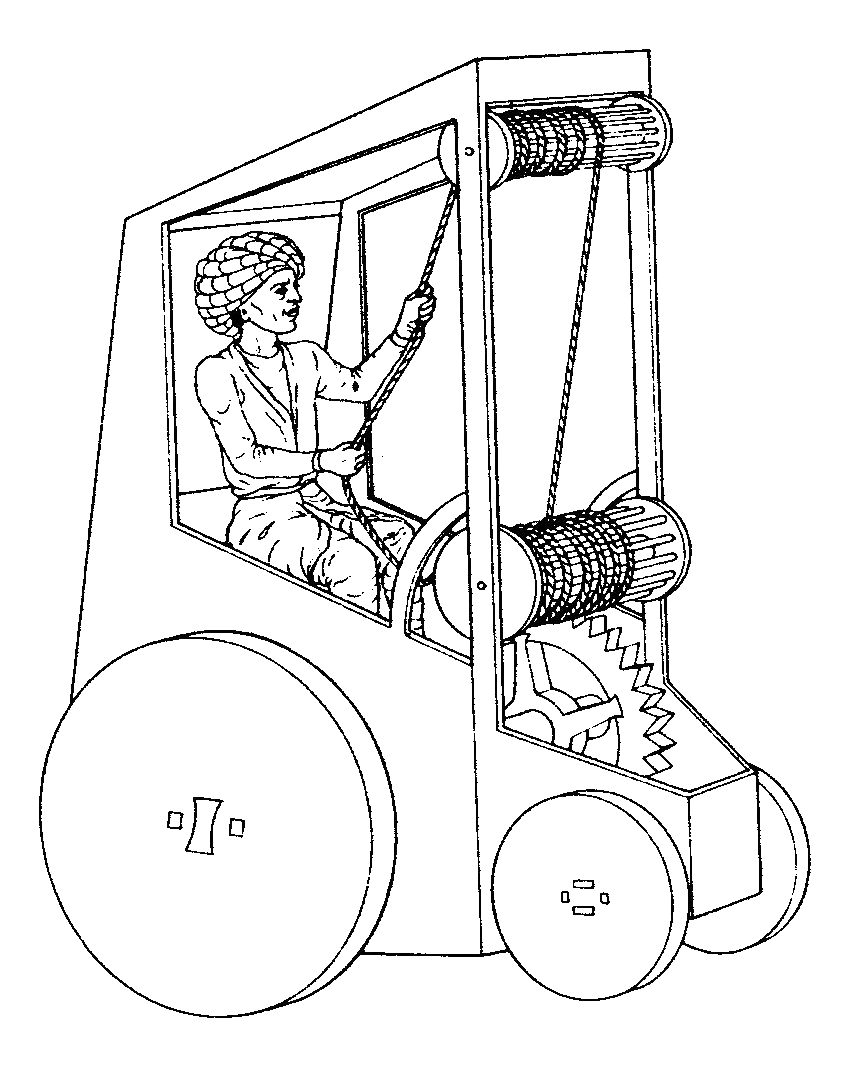
Another early concept was described in the book Bicycle by David V. Herlihy:
More than three centuries ago, the distinguished French mathematician Jacques Ozanam spelled out the theoretical advantages of a human-powered carriage “in which one can drive oneself wherever one pleases, without horses.” Its owner could freely roam along the roads without having to care for an animal and might even enjoy a healthy exercise in the process. Moreover, this particular type of “self-moving” vehicle, in contrast to those that called for wind or steam for propulsion, would run on that most abundant and accessible of all resources: willpower. But how to construct such a valuable vehicle? That was the twenty-third of some fifty “useful and entertaining” problems Ozanam identified and addressed in his famous Récréations Mathématiques et Physiques, published in 1696.
Ozanam’s book presented a proposed solution from another inventor: another four-wheeled carriage, driven by two people (one to steer, one to power the vehicle by stepping up and down on large treadles connected to the wheels by ropes, pulleys, and gears).
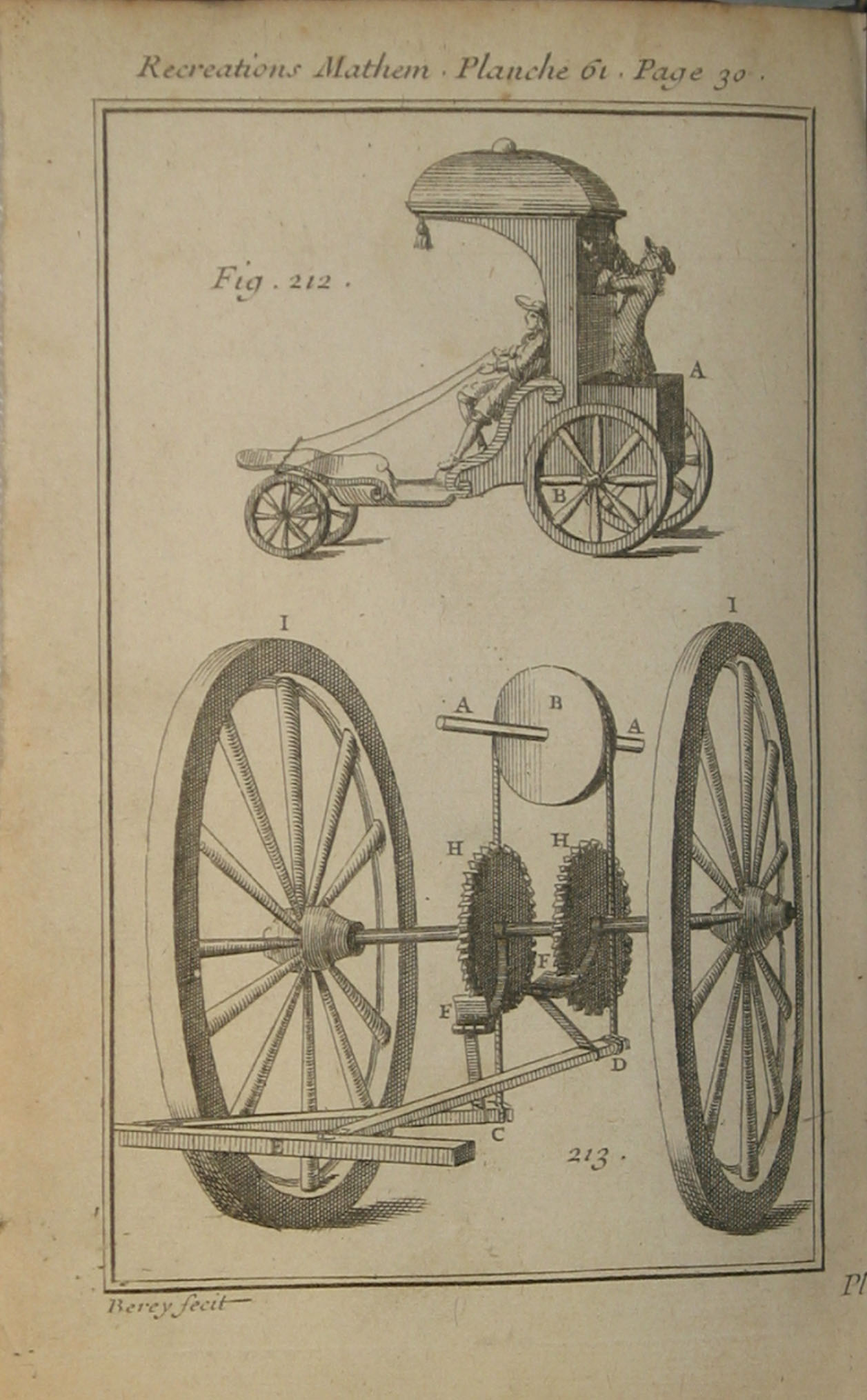
It seems that for centuries, the carriage was the model for human-powered vehicles. Various inventors tried their hand at designs, and some were even built. There is a record in a London journal of an attempt in 1774 that went up to six miles an hour. French inventor Jean-Pierre Blanchard (who would later go on to fame in ballooning) built a human-powered carriage that went a dozen miles from Paris to Versailles. An American mechanic named Bolton built a version in 1804 that used mechanical leverage from interlocking gears. Presumably, all these attempts went nowhere because the machines were too large and heavy to be practical.
The key insight was to stop trying to build a mechanical carriage, and instead build something more like a mechanical horse. This step was taken by the aforementioned Karl von Drais in the early 1800s. Drais was an aristocrat; he held a position as forest master in Baden that is said to have given him free time to tinker. His first attempts, beginning in 1813, were four-wheeled carriages like their predecessors, and like them failed to gain the support of authorities.
But in 1817 (possibly motivated by the aforementioned food crisis and resultant shortage of horses, although this is unclear), he tried again with a new design: a two-wheeled, one-person vehicle that is a recognizable ancestor of the modern bicycle. It was made of wood, with iron tires. He called it the Laufmaschine, or “running machine”; it had no pedals, and instead was powered by directly pushing off the ground with one’s feet. It was also called the “velocipede” (from the Latin for “swift foot”) or the “draisine” (English) or “draisienne” (French) after its inventor; an improved version made by a London coachmaker was known in England as the “pedestrian curricle”.
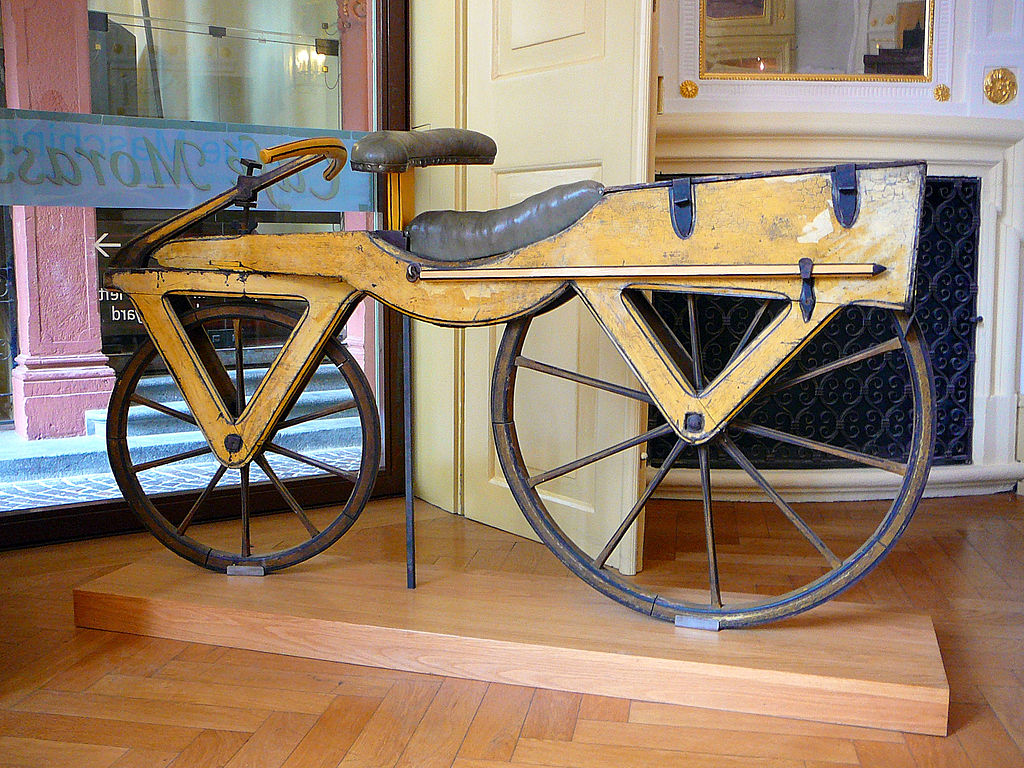
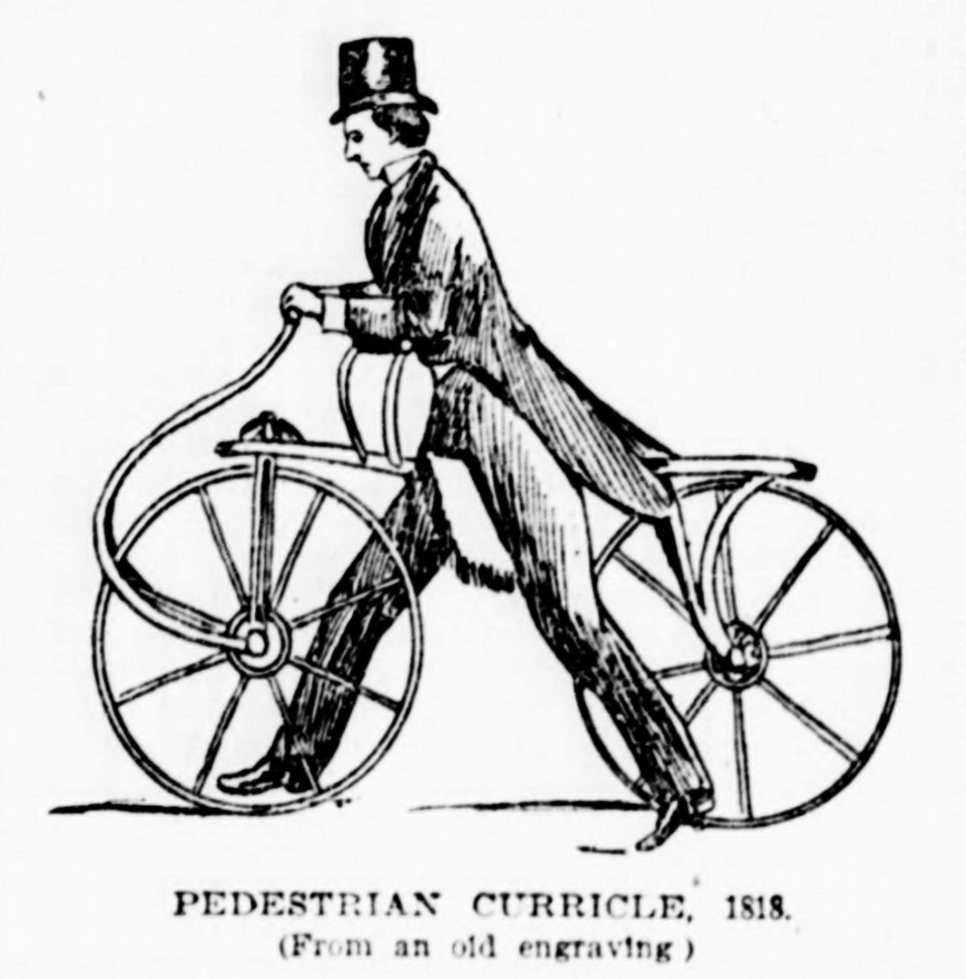
Without pedals or gears, this proto-bicycle couldn’t achieve the speed or efficiency of modern designs. But, like the scooters still used by children today, it allowed you to coast, especially downhill, and it held your weight as you moved forward. Drais got up to 12 miles per hour on his machine. It became a fad in Europe in 1818–19, then faded. It seems the reasons were a combination of the potential for injury and the general annoyance of the public that these things were being driven through pedestrian areas such as sidewalks and parks (some things never change; we’re repeating this today with the scooter wars in San Francisco and other cities).
The next key advance didn’t come until decades later, when someone put pedals on the bike. There are conflicting claims to first inventor (going back to 1839), but it was definitely done by the 1860s in France. In any case, it was in the 1860s that bicycle development really took off. Pedals allowed the rider to propel the machine faster and more efficiently. This model was manufactured in France, at first with wooden frames, later with iron, and became commonly known as the “boneshaker” (which gives you an idea of how rough the ride still was).
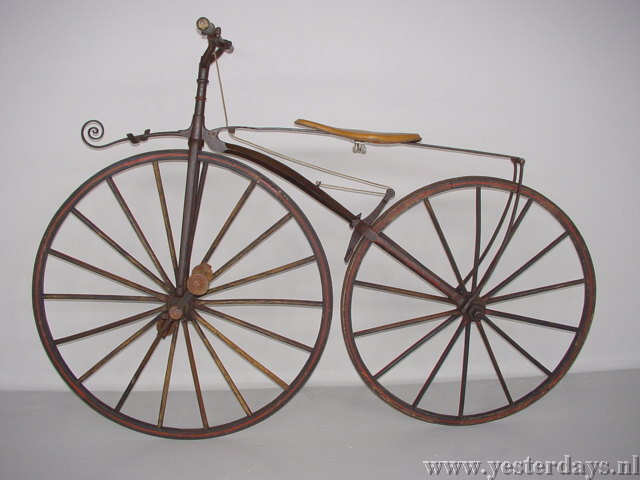
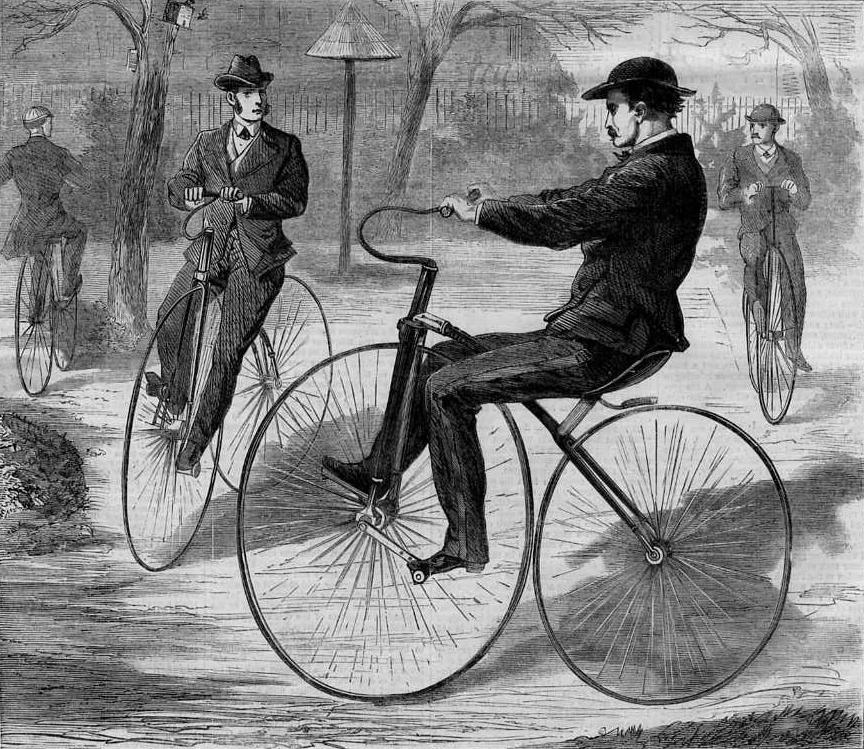
At this point, though, there were still no gears or chains. The pedals were attached directly to the front wheel. This gave the rider little mechanical advantage: it’s the same as a fixie with a 1:1 gear ratio (vs. the ratios most commonly used today which are closer to 3:1). Think of what it’s like to pedal a bike that’s in too low a gear: you pump your legs a lot without going very fast.
The only solution was to make the wheel larger, leading around 1870 to the ridiculous-looking “penny-farthing” or “high-wheel” design with the huge front wheel, which you’ve probably seen and may associate with the late 1800s. By around this time, bicycles were being made with metal frames, wire-spoke wheels, and solid rubber (not yet inflatable) tires. This design did give a faster ride, and a smoother one, since the large wheel absorbed shocks better. But it required acrobatic balance to ride, and as noted above it was prone to nasty spills and injuries, including “taking a header” if you stopped suddenly.
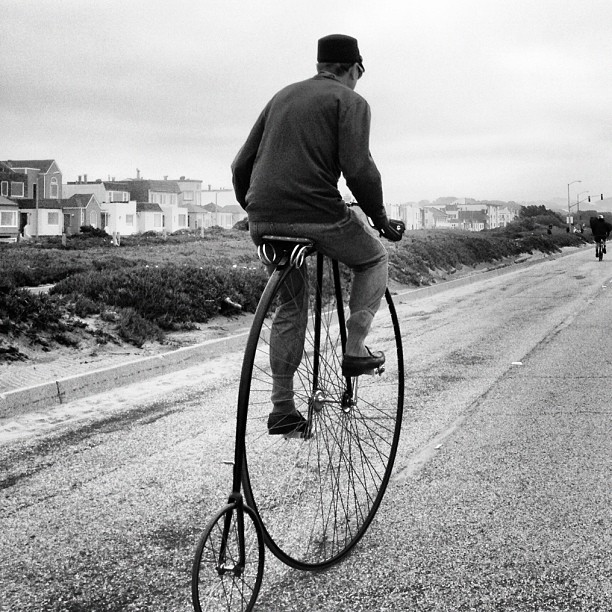
The third and final key advance, then, was to separate the pedals from the wheel. Variations on this “safety bicycle”, including at least one driven by treadles and levers, were attempted from the 1870s if not before. The first commercially successful model, using the familiar crank and chain design, was produced in 1885 by John Starley. Finally, in 1888, inflatable (pneumatic) tires were introduced by John Dunlop, cushioning the ride and eliminating the last advantage of the penny-farthing.
So, by the end of the 1880s, bicycles had evolved into the form we know them today, with (approximately) equal-sized wheels, pedals, chains, metal frames, wire-spoke wheels, and inflatable rubber tires.
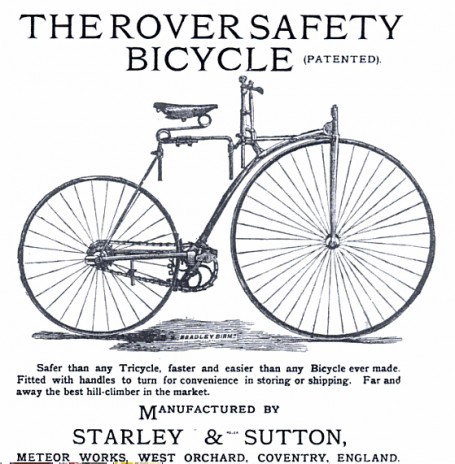
So what can we conclude?
First, the correct design was not obvious. For centuries, progress was stalled because inventors were all trying to create multi-person four-wheeled carriages, rather than single-person two-wheeled vehicles. It’s unclear why this was; certainly inventors were copying an existing mode of transportation, but why would they draw inspiration only from the horse-and-carriage, and not from the horse-and-rider? (Some commenters have suggested that it was not obvious that a two-wheeled vehicle would balance, but I find this unconvincing given how many other things people have learned to balance on, from dugout canoes to horses themselves.) It’s possible (I’m purely speculating here) that early mechanical inventors had a harder time realizing the fundamental impractiability of the carriage design because they didn’t have much in the way of mathematical engineering principles to go on, but then again it’s unclear what led to Drais’s breakthrough.
And even after Drais hit on the two-wheeled design, it took multiple iterations, which happened over decades, to get to a design that was efficient, comfortable, and safe.
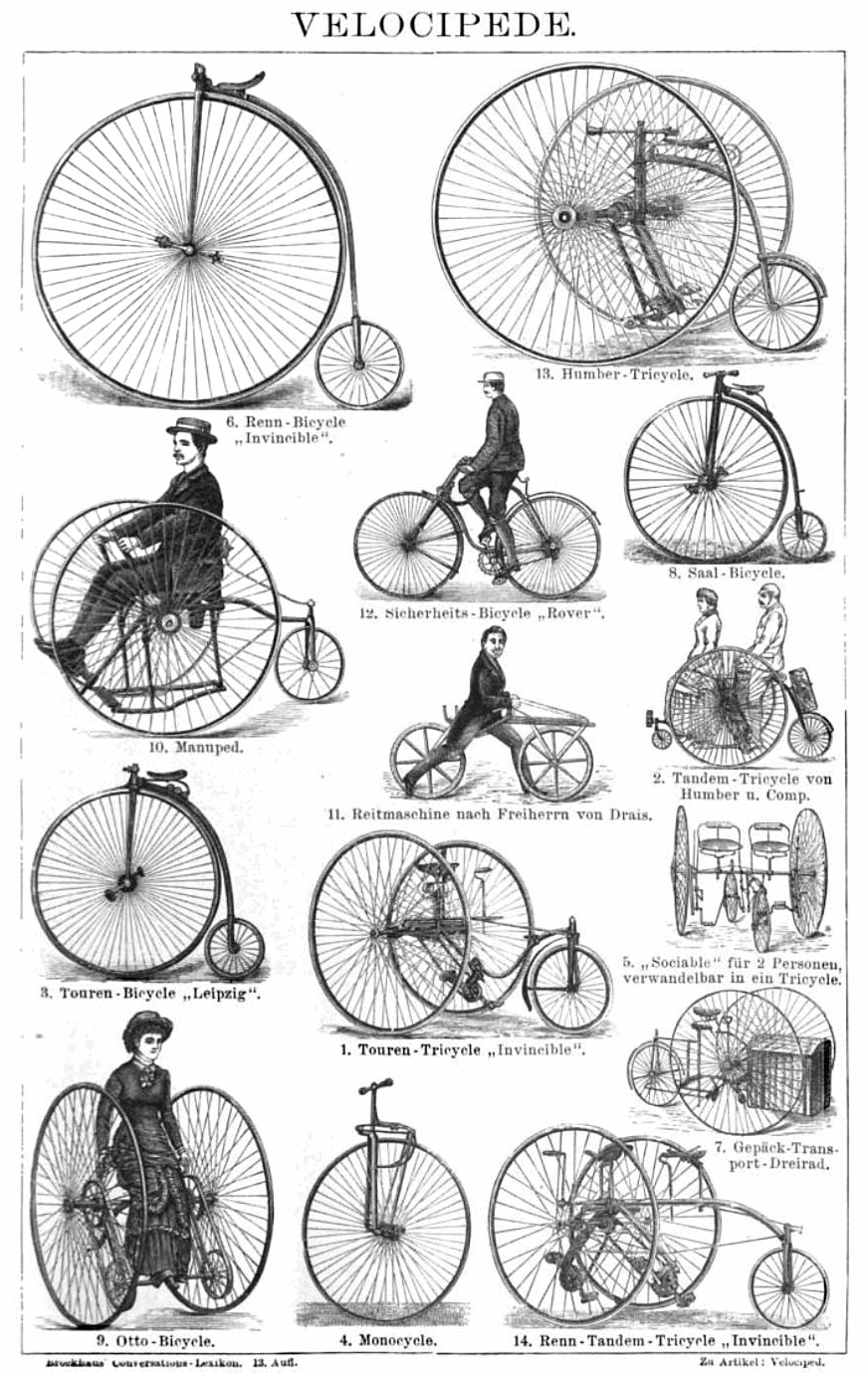
Second, advances in materials and manufacturing were probably necessary for a commercially successful bicycle. It’s a bit hard, from where I stand, to untangle which advances in design were made possible by new materials and techniques, and which were simply sparks of inventive imagination that hadn’t been conceived or developed before. But the fact that people were willing to put up with the precarious high-wheeled design indicates to me that pneumatic tires were crucial. And it’s plausible to me that advanced metalworking was needed to make small, lightweight chains and gears of high and consistent quality, at an acceptable price—and that no other design, such as a belt or lever, would have worked instead. It’s also plausible to me that wooden frames just weren’t light and strong enough to be practical (I certainly wouldn’t be eager to ride a wooden bicycle today).
But we can go deeper, and ask the questions that inspired my intense interest in this question in the first place. Why was no one even experimenting with two-wheeled vehicles until the 1800s? And why was no one, as far as we know, even considering the question of human-powered vehicles until the 1400s? Why weren’t there bicycle mechanics in the 1300s, when there were clockmakers, or at least by the 1500s, when we had watches? Or among the ancient Romans, who built water mills and harvesting machines? Or the Greeks, who built the Antikythera mechanism ? Even if they didn’t have tires and chains, why weren’t these societies at least experimenting with draisines? Or even the failed carriage designs?
To even begin to answer this, we have to realize that it’s part of a much wider phenomenon. I asked the same question of the cotton gin, which unlike the bicycle did not require advanced materials: it’s a wooden box, a wire mesh, and a drum with wire teeth; in fact, it was so simple that once the concept was out, plantation owners made bootleg copies by hand (depriving Eli Whitney of most of his patent royalties). The same question can be asked of all of the key inventions of textile mechanization; Anton Howes, an economic historian who chimed in on the Twitter thread linked above, has noted of John Kay’s flying shuttle:
Kay’s innovation was extraordinary in its simplicity. As the inventor Bennet Woodcroft put it, weaving with an ordinary shuttle had been “performed for upwards of five thousand years, by millions of skilled workmen, without any improvement being made to expedite the operation, until the year 1733”. All Kay added was some wood and some string. And he applied it to weaving wool, which had been England’s main industry since the middle ages. He had no special skill, he required no special understanding of science for it, and he faced no special incentive to do it. As for institutions, the flying shuttle was technically illegal because it saved labour, the patent was immediately pirated by competitors to little avail, and Kay was forced to move to France, hounded out of the country by angry weavers who threatened his property and even his life. Kay faced no special incentives — he even innovated despite some formidable social and legal barriers.
There are also other stories in which an early attempt at invention was demonstrated, the idea found no backers if it wasn’t already fully viable, and then development was dropped for decades. Richard Trevithick’s early, failed experiments with locomotives come to mind.
In light of this, I think the deepest explanation is in general economic and cultural factors. Regarding economic factors, it seems that there needs to be a certain level of surplus to support the culture-wide research and development effort that creates inventions. Note that Karl von Drais was a baron who apparently had a cushy job and invented in his spare time. This is common of researchers of that era: they were often aristocrats or otherwise independently wealthy (and those who weren’t had to scramble for support from wealthy patrons). Today we have research labs in both universities and corporations, plus venture capitalists to fund development of new products and services. The moment it becomes clear that a certain type of innovation might be possible, there are multiple teams funded and hustling to bring it to market. There are no multi-decade gaps in the innovation timeline anymore, or at least vastly fewer.
Looking at economic factors on the demand side, surplus also would seem to create markets for new products. Maybe GDP per capita just has to hit a certain point before people even have time, attention and energy to think about new inventions that aren’t literally putting food on the table, a roof over your head, or a shirt on your back.
Finally, there are cultural factors. Howes says that “innovation is not in human nature, but is instead received. … when people do not innovate, it is often simply because it never occurs to them to do so.” Joel Mokyr says, similarly, that “progress isn’t natural” (and his book on this topic, A Culture of Growth, helped inspire this blog). I agree with both.
Fully elucidating these economic and cultural factors is a major future project of this blog.
Sources and further reading: Excerpt from Bicycle, by David V. Herlihy, “Of Velocipedes and Draisiennes”, “Who Invented the Bicycle?”, and many Wikipedia articles including “History of the bicycle”.
